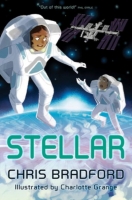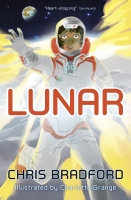In a celebration of World Space Week author Chris Bradford has shared with us the inspiration behind his thrilling space stories, Lunar and Stellar both published by dyslexia specialists Barrington Stoke.
Chris has captivated readers worldwide with his gripping tales of adventure, courage, and resilience. Today, we venture into a new dimension of his storytelling as we delve into his fascination with space and the cosmos.
In this special feature, Chris Bradford opens up about his passion for space exploration and how the mysteries of the universe have influenced his writing. From the allure of distant galaxies to the challenges of interstellar travel, we'll discover how these cosmic elements inspire his narratives and perhaps even hint at exciting new projects on the horizon.
Join us as we embark on this stellar journey with Chris, exploring the intersection of his dynamic storytelling and the boundless wonders of space. Whether you're a longtime fan or new to his work, this insightful conversation promises to ignite your imagination and take you on an adventure that's truly out of this world. Here's what he had to say:
 "The stars have been a fascination for humankind and an inspiration for stories for thousands upon thousands of years. For me, the cosmic inspiration behind my new books, Lunar and Stellar, is much more recent - NASA's Artemis Program.
"The stars have been a fascination for humankind and an inspiration for stories for thousands upon thousands of years. For me, the cosmic inspiration behind my new books, Lunar and Stellar, is much more recent - NASA's Artemis Program.
Their mission to return to the Moon for the first time since the Apollo 17 mission in 1972 marks the start of a new Space Race. This time round, there are many more competitors entering the race: India, China, Japan, UAE and even private companies. All keen to mine the lunar surface for its potential multi-billion-dollar resources – helium, silicon, iron and other precious minerals and gases.
However, I’ve mined the Moon for story ideas!
In Lunar, a young girl finds herself stranded on the Moon after a devastating meteor strike destroys her base. With few supplies and no shelter, Luna must use her wits and science knowledge to survive on a desolate lunar landscape until rescue can come. The problem is – any hope of rescue is at least three days and 400,000 kilometres away… and her oxygen is fast running out!
 In Stellar, a massive solar flare sets off a string of disasters that sends siblings Stella and Ryan spinning off into deep outer space. With radio communications dead, the two siblings will need all their knowledge of the stars and a whole galaxy of luck to find their way back to Earth.
In Stellar, a massive solar flare sets off a string of disasters that sends siblings Stella and Ryan spinning off into deep outer space. With radio communications dead, the two siblings will need all their knowledge of the stars and a whole galaxy of luck to find their way back to Earth.
Lunar and Stellar are part of a planned trio of gripping space survival stories, concluding with Nova next year. These interstellar adventures are packed with fascinating details about the Moon and Space and, most importantly, based on real science. My goal with these books is not only to tell an exciting story but to ignite readers' imaginations about what life in space and on the Moon could be like.
During my research, I’ve discovered facts are often stranger than fiction and weaving such facts into my stories makes them more authentic and engaging, especially for younger or more reluctant readers.
For example, did you know that the Moon smells like burnt gunpowder? The smell comes from the lunar dust that clings to astronauts' spacesuits after they return from moonwalks. Then there’s the issue of lunar hay fever. Yes, that’s a real thing! The Moon’s dust is so fine and sharp that it can irritate astronauts' lungs, leading to sneezing, coughing, and congestion. In Lunar, Luna suffers this same issue as she tries to battle to survive on the Moon’s harsh surface.
In Stellar, siblings Stella and Ryan must grapple with the effects of zero gravity. A lack of gravity does strange things to the human body: muscles weaken, bones lose density, and astronauts can get space sick! On the other hand, zero gravity can give you ‘superpowers’, like the ability to lift heavy objects with ease or float effortlessly through the air, just as Stella and Ryan must do in their fraught race to survive.
By reading Lunar and Stellar, young readers can also learn the answers to such intriguing questions as: Can you hear an explosion in space? How fast does the International Space Station travel? And what happens if you take off your helmet in space? (Spoiler: it’s not pretty!)
My hope is that these stories will do more than entertain — they will educate and inspire. The Artemis missions aim to return humans to the Moon, but this goal is just the beginning to the new Space Race. The Moon is seen as a launchpad to travel to Mars and beyond. So I want my books to spark curiosity in readers who may one day grow up to be the astronauts, scientists, and engineers leading those missions.
While NASA’s mission is to get humans living on the Moon, my mission is to get kids reading. I believe that storytelling, especially when grounded in real science, has the power to engage even the most reluctant readers. By fusing together thrilling action and fascinating facts, I hope to show that reading can be as exciting as blasting off into space. So whether you're dreaming of becoming an astronaut or just looking for a cosmic adventure, Lunar and Stellar offer a journey that’s both thrilling and educational."

Reach for the stars — or a book — you never know what you might discover!
To discover more about Chris Bradford and his books, visit www.chrisbradford.co.uk
Find our more about World Space Week 4-10 October 2024 - www.worldspaceweek.org
Explore more space-themed titles here


.jpg)


Comments (0)
Leave A Reply
You must be logged in to post a comment.